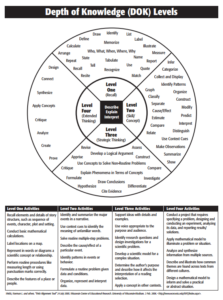 I recently got a question from a reader asking how the lessons in my K-8 curriculum supported Dr. Norman Webb’s Depth of Knowledge philosophy — an integral concept to her school’s mission. It got me thinking about lesson plans in general — how far we’ve come from lecture-test-move on. Now, exemplary teachers focus on blending learning into the student’s life knowledge base with the goal of building happy, productive adults. There are several concepts that address this reform in teaching (such as Art Costa’s Habits of Mind, Bloom’s Taxonomy, the Hess Cognitive Rigor Matrix, or the tech-oriented SAMR Model). Depth of Knowledge (DoK) is arguably the most thorough with its four concise levels, each supported by a collection of words that contribute to delivering content at that level. Like the SAMR Model, involvement grows with each level from a basic recall of knowledge to the ability to use that information in new circumstances.
I recently got a question from a reader asking how the lessons in my K-8 curriculum supported Dr. Norman Webb’s Depth of Knowledge philosophy — an integral concept to her school’s mission. It got me thinking about lesson plans in general — how far we’ve come from lecture-test-move on. Now, exemplary teachers focus on blending learning into the student’s life knowledge base with the goal of building happy, productive adults. There are several concepts that address this reform in teaching (such as Art Costa’s Habits of Mind, Bloom’s Taxonomy, the Hess Cognitive Rigor Matrix, or the tech-oriented SAMR Model). Depth of Knowledge (DoK) is arguably the most thorough with its four concise levels, each supported by a collection of words that contribute to delivering content at that level. Like the SAMR Model, involvement grows with each level from a basic recall of knowledge to the ability to use that information in new circumstances.
Here are general details about Webb’s DoK:
- With Webb’s DoK chart, not only can you figure out how to teach a subject more deeply and expect students to demonstrate complex understanding, but teachers can evaluate where students are in the four-step process starting at the rote application of knowledge to its synthesization from various sources that is then transferred to other uses.
- Level One: Identify details in the text, specific facts that result in a ‘right’ answer. Tasks that require Level One thinking include words like memorize, state, and recognize.
- Level Two: Show a relationship between an idea in the text and other events. ‘How’ and ‘why’ are good questions to bump an activity into Level Two. Tasks that require Level Two thinking include words like compare, infer, and interpret.
- Level Three: Analyze and draw conclusions about the text. Support conclusions with details. Use a voice that is appropriate to the purpose, task, and audience. Tasks that require Level Three thinking include words like hypothesize, differentiate, and investigate.
- Level Four: Extend conclusions and analysis (which might be the result of Level three) to new situations. Use other sources to analyze and draw conclusions. Tasks that require Level Four thinking include words like connect, analyze, and prove.
- As Dr. Karin Hess says, DoK is not about difficulty, it’s about complexity. Level One may be difficult for some students, but it isn’t complex. They may memorize a calculus formula (which I’ll stipulate is beyond difficult), but it doesn’t represent rigorous thinking. That happens in Level Four’s application to the real world.
- For DoK’s Level One and Two, there are usually right answers. That’s not true in Levels Three and Four.There, it’s about higher-order thinking.
- DoK is not a taxonomy (like Bloom’s). Rather, it itemizes ways students interact with knowledge.
- To work at a Level Three or Four requires foundation. Show students how to accomplish Level One and Two goals first.
With that in mind, here are seven steps to transform your current lesson plan into one aligned with DoK guidelines:
- Definitely, notice which standards your lessons meet, be it CCSS, IB, or your state standards, but also evaluate where it falls in the
 four levels of Depth of Knowledge. Are you introducing concepts or asking students to build on prior knowledge? If students are identifying places on a map (a Level One activity), is that sufficient? Or should you extend their thinking to relate the latitude to other locations and habitats around the world?
four levels of Depth of Knowledge. Are you introducing concepts or asking students to build on prior knowledge? If students are identifying places on a map (a Level One activity), is that sufficient? Or should you extend their thinking to relate the latitude to other locations and habitats around the world? - Even in Level one activities (such as math facts), expect students to demonstrate their understanding of the process and to transfer that to new circumstances.
- Reading questions like who, what, when, where easily fall into Level 1. By adding the question ‘Why‘, you challenge students to think, analyze, and draw conclusions.
- As you teach the lesson, use relevant words from the DoK chart. Expect students to think cognitively — to critique, revise, memorize, and compare throughout their learning. For example, prior to using a digital tool, ask them to evaluate why that is the best approach using a compare-contrast chart that includes all other options. Results may differ between students and that is fine.
- Instead of structuring the lesson, share the Big Idea and Essential Questions and ask students to define the best approach to accomplishing these goals based on their learning style.
- Assess based on a wide variety of options, including recall of past knowledge, applying skills and concepts learned, strategic thinking, tenacity, problem solving, and the ability to extend knowledge to new related or unrelated circumstances.
- Extend lessons for students who finish early allowing them to dig deeper into what they’ve learned or extrapolate it to the next phase.
When you use Depth of Knowledge in lesson planning, you ask students to think deeper, base conclusions off of evidence, and incorporate prior knowledge into current tasks. These not only serve students in their education, but the career path they choose after leaving the schoolhouse.
Jacqui Murray has been teaching K-18 technology for 30 years. She is the editor/author of over a hundred tech ed resources including a K-12 technology curriculum, K-8 keyboard curriculum, K-8 Digital Citizenship curriculum. She is an adjunct professor in tech ed, Master Teacher, webmaster for four blogs, an Amazon Vine Voice, CSTA presentation reviewer, freelance journalist on tech ed topics, contributor to NEA Today, and author of the tech thrillers, To Hunt a Sub and Twenty-four Days. You can find her resources at Structured Learning.





































2 thoughts on “How to Blend DoK into Lesson Plans without a Comprehensive Rewrite”
Comments are closed.